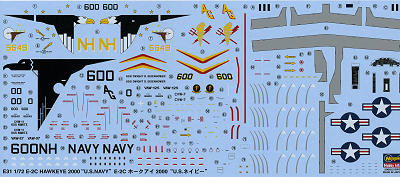
Hasegawa 1/72 E-2C Hawkeye 2000
| KIT #: | 01561 |
| PRICE: | $58.95 MSRP |
| DECALS: | Two options |
| REVIEWER: | Scott Van Aken |
| NOTES: | Brand new molding |

| HISTORY |
Since replacing the E-1 in 1964, the Hawkeye has been the "eyes of the fleet." Since its combat debut during theVietnam conflict, the E-2 has served the US Navy around the world. Hawkeyes (from VAW-123 "Screwtops" aboard the USS America) directedF-14 fighters flying combat air patrol duringOperation El Dorado Canyon, the two-carrier battle group joint strike against terrorist-relatedLibyan targets in 1986. More recently, E-2Cs provided the command and control for successful operations during theGulf War, directing both land attack and combat air patrol missions over Iraq and providing control for the shoot-down of twoIraqi MiG-21 aircraft by carrier-basedF/A-18s in the early days of the war. E-2 aircraft also have worked extremely effectively with US law enforcement agencies in drug interdictions.
DuringOperation Enduring Freedom andOperation Iraqi Freedom all ten Hawkeye squadrons flew overland sorties. They provided critical battle management for attack of enemy ground targets, close-air-support coordination, combat search and rescue control, airspace management, as well as datalink and communication relay for both land and naval forces. DuringHurricane Katrina three Hawkeye squadrons were deployed in support of urban relief efforts includingAir Traffic Control responsibilities spanning three states, and control ofCoast Guard andNational Guard helicopter rescue units.
Hawkeye 2000s first deployed in 2003 aboardUSS Nimitz with VAW-117 "Wallbangers" and CVW-11. The U.S. Navy Hawkeyes have now been upgraded with eight bladed propellors as part of the NP2000 program; the first squadron to cruise with the new propellers was VAW-124 "Bear Aces". The latest version can track more than 2,000 targets simultaneously (while at the same time, detecting 20,000 simultaneously) to a range greater than 400 miles (650 km) and simultaneously guide 40–100 air to air intercepts or air to surface engagements.
In late 2006, the US announced that it intended to sell threeP-3C Orions equipped with the E-2C Hawkeye 2000 system to the Pakistan Navy. These aircraft will provide Pakistan with search surveillance, and control capability in support of maritime interdiction operations. Though once considered being replaced byCommon Support Aircraft, the original plan failed to materialize, and E-2 will continue its role as the primary AEW aircraft in USN in the near future.
| THE KIT |
 We had the basic boxing of the '
We had the basic boxing of the ' early' E-2C and now we have the basic boxing of the current version the Hawkeye 2000. Everything I said about the JASDF boxing of the E-2C is true of this version as 99 percent of the pieces are identical. The only difference between the two are two small sprues. One is for the new props and spinners and the other is for th e new lower center fuselage insert. In addition to the sprue layout to the left of the 'older' Hawkeye, I've included an image of the new sprues so you can see these for yourself (yes, I've only shown one prop sprue).
early' E-2C and now we have the basic boxing of the current version the Hawkeye 2000. Everything I said about the JASDF boxing of the E-2C is true of this version as 99 percent of the pieces are identical. The only difference between the two are two small sprues. One is for the new props and spinners and the other is for th e new lower center fuselage insert. In addition to the sprue layout to the left of the 'older' Hawkeye, I've included an image of the new sprues so you can see these for yourself (yes, I've only shown one prop sprue).
 Of course, the instructions show this difference and provide markings for two of the 12 (or is it 21) new build Hawkeye 2000s, which some are called the E-2D. Both of these aircraft are CAG birds with the more flamboyant of the two being the box art plane of VAW-117 'Wallbangers'. The other is from VAW-125 'Tiger Tails'. This version has the dark Navy Blue of the rudder continue onto the horizontal tailplane if you so wish.
Of course, the instructions show this difference and provide markings for two of the 12 (or is it 21) new build Hawkeye 2000s, which some are called the E-2D. Both of these aircraft are CAG birds with the more flamboyant of the two being the box art plane of VAW-117 'Wallbangers'. The other is from VAW-125 'Tiger Tails'. This version has the dark Navy Blue of the rudder continue onto the horizontal tailplane if you so wish.
The decals for these planes are both very nicely printed and are the 'new' type with the nice bright whites and the properly shaded reds. The sheet is also very large and would not entirely fit on the platen of my scanner. It includes prop markings as well as walkways and the usual data markings.
| CONCLUSIONS |
So now we have both types and this should start a mass reboxing and long line of limited release kits; both of the new and the 'older' versions of the E-2C. It will be interesting to see if they do a really special boxing with resin bits to backdate the kit to a E-2A/B version. Stay tuned.
| REFERENCES |
February 2009
My thanks to www.hlj.com for the review kit. Get yours today at Japanese prices. If you would like your product reviewed fairly and fairly quickly, please contact the editor or see other details in the